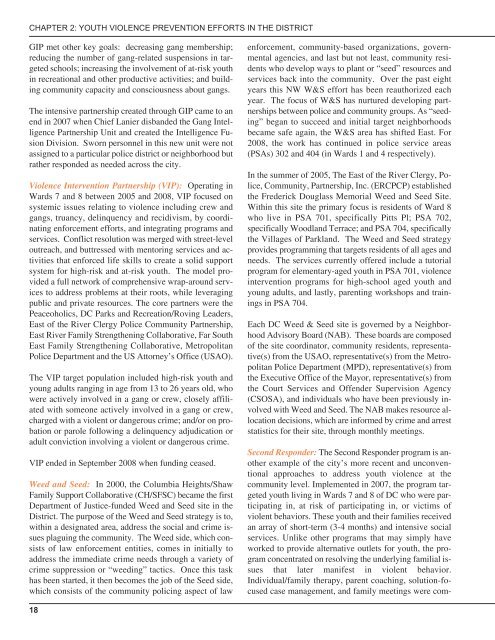Responding to Gang, Crew and Youth Violence in the District of Columbia
Responding to Gang, Crew and Youth Violence in the District of Columbia
Responding to Gang, Crew and Youth Violence in the District of Columbia
Create successful ePaper yourself
Turn your PDF publications into a flip-book with our unique Google optimized e-Paper software.
CHAPTER 2: YOUTH VIOLENCE PREVENTION EFFORTS IN THE DISTRICTGIP met o<strong>the</strong>r key goals: decreas<strong>in</strong>g gang membership;reduc<strong>in</strong>g <strong>the</strong> number <strong>of</strong> gang-related suspensions <strong>in</strong> targetedschools; <strong>in</strong>creas<strong>in</strong>g <strong>the</strong> <strong>in</strong>volvement <strong>of</strong> at-risk youth<strong>in</strong> recreational <strong>and</strong> o<strong>the</strong>r productive activities; <strong>and</strong> build<strong>in</strong>gcommunity capacity <strong>and</strong> consciousness about gangs.The <strong>in</strong>tensive partnership created through GIP came <strong>to</strong> anend <strong>in</strong> 2007 when Chief Lanier disb<strong>and</strong>ed <strong>the</strong> <strong>Gang</strong> IntelligencePartnership Unit <strong>and</strong> created <strong>the</strong> Intelligence FusionDivision. Sworn personnel <strong>in</strong> this new unit were notassigned <strong>to</strong> a particular police district or neighborhood butra<strong>the</strong>r responded as needed across <strong>the</strong> city.<strong>Violence</strong> Intervention Partnership (VIP): Operat<strong>in</strong>g <strong>in</strong>Wards 7 <strong>and</strong> 8 between 2005 <strong>and</strong> 2008, VIP focused onsystemic issues relat<strong>in</strong>g <strong>to</strong> violence <strong>in</strong>clud<strong>in</strong>g crew <strong>and</strong>gangs, truancy, del<strong>in</strong>quency <strong>and</strong> recidivism, by coord<strong>in</strong>at<strong>in</strong>genforcement efforts, <strong>and</strong> <strong>in</strong>tegrat<strong>in</strong>g programs <strong>and</strong>services. Conflict resolution was merged with street-leveloutreach, <strong>and</strong> buttressed with men<strong>to</strong>r<strong>in</strong>g services <strong>and</strong> activitiesthat enforced life skills <strong>to</strong> create a solid supportsystem for high-risk <strong>and</strong> at-risk youth. The model provideda full network <strong>of</strong> comprehensive wrap-around services<strong>to</strong> address problems at <strong>the</strong>ir roots, while leverag<strong>in</strong>gpublic <strong>and</strong> private resources. The core partners were <strong>the</strong>Peaceoholics, DC Parks <strong>and</strong> Recreation/Rov<strong>in</strong>g Leaders,East <strong>of</strong> <strong>the</strong> River Clergy Police Community Partnership,East River Family Streng<strong>the</strong>n<strong>in</strong>g Collaborative, Far SouthEast Family Streng<strong>the</strong>n<strong>in</strong>g Collaborative, MetropolitanPolice Department <strong>and</strong> <strong>the</strong> US At<strong>to</strong>rney’s Office (USAO).The VIP target population <strong>in</strong>cluded high-risk youth <strong>and</strong>young adults rang<strong>in</strong>g <strong>in</strong> age from 13 <strong>to</strong> 26 years old, whowere actively <strong>in</strong>volved <strong>in</strong> a gang or crew, closely affiliatedwith someone actively <strong>in</strong>volved <strong>in</strong> a gang or crew,charged with a violent or dangerous crime; <strong>and</strong>/or on probationor parole follow<strong>in</strong>g a del<strong>in</strong>quency adjudication oradult conviction <strong>in</strong>volv<strong>in</strong>g a violent or dangerous crime.VIP ended <strong>in</strong> September 2008 when fund<strong>in</strong>g ceased.Weed <strong>and</strong> Seed: In 2000, <strong>the</strong> <strong>Columbia</strong> Heights/ShawFamily Support Collaborative (CH/SFSC) became <strong>the</strong> firstDepartment <strong>of</strong> Justice-funded Weed <strong>and</strong> Seed site <strong>in</strong> <strong>the</strong><strong>District</strong>. The purpose <strong>of</strong> <strong>the</strong> Weed <strong>and</strong> Seed strategy is <strong>to</strong>,with<strong>in</strong> a designated area, address <strong>the</strong> social <strong>and</strong> crime issuesplagu<strong>in</strong>g <strong>the</strong> community. The Weed side, which consists<strong>of</strong> law enforcement entities, comes <strong>in</strong> <strong>in</strong>itially <strong>to</strong>address <strong>the</strong> immediate crime needs through a variety <strong>of</strong>crime suppression or “weed<strong>in</strong>g” tactics. Once this taskhas been started, it <strong>the</strong>n becomes <strong>the</strong> job <strong>of</strong> <strong>the</strong> Seed side,which consists <strong>of</strong> <strong>the</strong> community polic<strong>in</strong>g aspect <strong>of</strong> lawenforcement, community-based organizations, governmentalagencies, <strong>and</strong> last but not least, community residentswho develop ways <strong>to</strong> plant or “seed” resources <strong>and</strong>services back <strong>in</strong><strong>to</strong> <strong>the</strong> community. Over <strong>the</strong> past eightyears this NW W&S effort has been reauthorized eachyear. The focus <strong>of</strong> W&S has nurtured develop<strong>in</strong>g partnershipsbetween police <strong>and</strong> community groups. As “seed<strong>in</strong>g”began <strong>to</strong> succeed <strong>and</strong> <strong>in</strong>itial target neighborhoodsbecame safe aga<strong>in</strong>, <strong>the</strong> W&S area has shifted East. For2008, <strong>the</strong> work has cont<strong>in</strong>ued <strong>in</strong> police service areas(PSAs) 302 <strong>and</strong> 404 (<strong>in</strong> Wards 1 <strong>and</strong> 4 respectively).In <strong>the</strong> summer <strong>of</strong> 2005, The East <strong>of</strong> <strong>the</strong> River Clergy, Police,Community, Partnership, Inc. (ERCPCP) established<strong>the</strong> Frederick Douglass Memorial Weed <strong>and</strong> Seed Site.With<strong>in</strong> this site <strong>the</strong> primary focus is residents <strong>of</strong> Ward 8who live <strong>in</strong> PSA 701, specifically Pitts Pl; PSA 702,specifically Woodl<strong>and</strong> Terrace; <strong>and</strong> PSA 704, specifically<strong>the</strong> Villages <strong>of</strong> Parkl<strong>and</strong>. The Weed <strong>and</strong> Seed strategyprovides programm<strong>in</strong>g that targets residents <strong>of</strong> all ages <strong>and</strong>needs. The services currently <strong>of</strong>fered <strong>in</strong>clude a tu<strong>to</strong>rialprogram for elementary-aged youth <strong>in</strong> PSA 701, violence<strong>in</strong>tervention programs for high-school aged youth <strong>and</strong>young adults, <strong>and</strong> lastly, parent<strong>in</strong>g workshops <strong>and</strong> tra<strong>in</strong><strong>in</strong>gs<strong>in</strong> PSA 704.Each DC Weed & Seed site is governed by a NeighborhoodAdvisory Board (NAB). These boards are composed<strong>of</strong> <strong>the</strong> site coord<strong>in</strong>a<strong>to</strong>r, community residents, representative(s)from <strong>the</strong> USAO, representative(s) from <strong>the</strong> MetropolitanPolice Department (MPD), representative(s) from<strong>the</strong> Executive Office <strong>of</strong> <strong>the</strong> Mayor, representative(s) from<strong>the</strong> Court Services <strong>and</strong> Offender Supervision Agency(CSOSA), <strong>and</strong> <strong>in</strong>dividuals who have been previously <strong>in</strong>volvedwith Weed <strong>and</strong> Seed. The NAB makes resource allocationdecisions, which are <strong>in</strong>formed by crime <strong>and</strong> arreststatistics for <strong>the</strong>ir site, through monthly meet<strong>in</strong>gs.Second Responder: The Second Responder program is ano<strong>the</strong>rexample <strong>of</strong> <strong>the</strong> city’s more recent <strong>and</strong> unconventionalapproaches <strong>to</strong> address youth violence at <strong>the</strong>community level. Implemented <strong>in</strong> 2007, <strong>the</strong> program targetedyouth liv<strong>in</strong>g <strong>in</strong> Wards 7 <strong>and</strong> 8 <strong>of</strong> DC who were participat<strong>in</strong>g<strong>in</strong>, at risk <strong>of</strong> participat<strong>in</strong>g <strong>in</strong>, or victims <strong>of</strong>violent behaviors. These youth <strong>and</strong> <strong>the</strong>ir families receivedan array <strong>of</strong> short-term (3-4 months) <strong>and</strong> <strong>in</strong>tensive socialservices. Unlike o<strong>the</strong>r programs that may simply haveworked <strong>to</strong> provide alternative outlets for youth, <strong>the</strong> programconcentrated on resolv<strong>in</strong>g <strong>the</strong> underly<strong>in</strong>g familial issuesthat later manifest <strong>in</strong> violent behavior.Individual/family <strong>the</strong>rapy, parent coach<strong>in</strong>g, solution-focusedcase management, <strong>and</strong> family meet<strong>in</strong>gs were com-18


